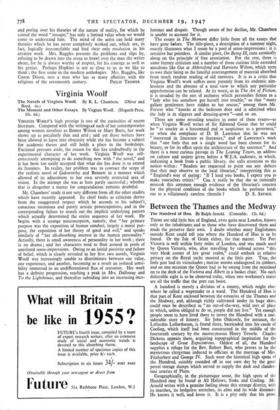Between the Thames and the Medway
The Hundred of Boo. By Ralph Arnold. (Constable. 12s. 6d.)
THERE are odd little bits of England, even quite near London, known only to the inhabitants and to those who have discovered them and made the preserve their own. I doubt whether many Englishmen outside Kent could tell you where the Hundred of Hoo is to be found. Or the Isle of Grain either, for that matter. Yet Port Victoria is well within forty miles of London, and was much used by Queen Victoria, who, after travelling by railroad across " this very bleak corner of her great realm," could embark in relative privacy on the Royal yacht moored at the little pier. True, the little pier had its vicissitudes ; marine worms endangered its timbers, and on one occasion the Queen had to be swung from the mainland on to the deck of the Victoria and Albert in a basket chair7 No such delectable sight is to be observed today, when two workmen's trains are all the traffic that the port can boast.
A hundred is merely a division of a county, which might else- where be called a wapentake or a ward. The Hundred of Hoo is that part of Kent enclosed between the estuaries of the Thames and the Medway, and, although richly cultivated under its huge skies, could once be described as "an out-of-the-way, wild sort of place in which, unless obliged to do so, people did not live." Yet enough people seem to have lived there to invest the Hundred with a con- siderable store of history. Sir John Oldcastle, for instance, the Lollardus Lollardorum, is found there, barricaded into his 'castle of Cooling, which itself had been constructed in the middle of the fourteenth century by the masterinason Henry Yeverle. Charles Dickens appears there, acquiring topographical inspiration for the landscape -of Great Expectations. Oddest of all, the Hundred supplies a refuge for the Rev. Robert Burt, who proves to be the mysterious clergyman induced to officiate at the marriage of Mrs. Fitzherbert and George IV. Such were the historical high spots of the Hundred, suitably rounded off in our own day by the great petrol storage dumps which served to supply the dark and clandes- tine arteries of Pluto.
Geographically, in the picturesque sense, the high spots of the Hundred may be found at All Hallows, Stoke and Cooling. Mr. Arnold writes with a genuine feeling about this strange district, with its marshes, its hedgeless stretches, its elms and its wide distances. He knows it well, and loves it. It is a pity only that his prose should not be more worthy of his knowledge and affection, but in truth his style is jerky, lacking in smoothness, and sometimes facetious; facts so confusedly presented that it is often necessary to go back and read the pages twice over. Love and sincerity, in literature, are not enough. Nevertheless, after recording these strictures, it should be added in a more lenient spirit that Mr. Arnold must remain as an indispensable guide to all those who would explore his sequestered peninsula. An index would have been welcome, but the illustrations are good and the general production is in accordance with what the fastidious reader expects from Messrs.



































 Previous page
Previous page